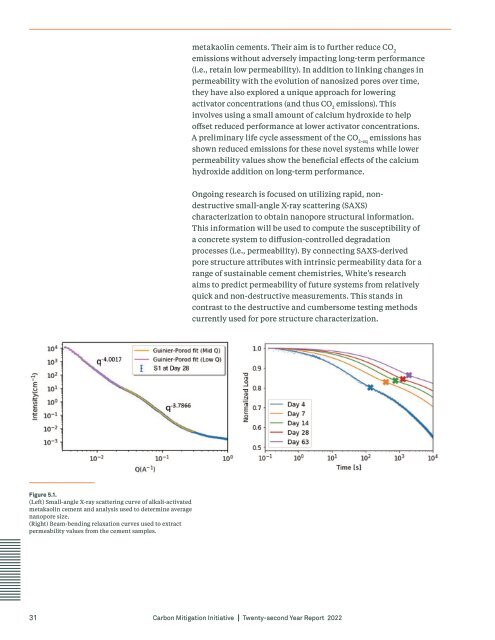CMI Annual Report 2022
Create successful ePaper yourself
Turn your PDF publications into a flip-book with our unique Google optimized e-Paper software.
metakaolin cements. Their aim is to further reduce CO 2<br />
emissions without adversely impacting long-term performance<br />
(i.e., retain low permeability). In addition to linking changes in<br />
permeability with the evolution of nanosized pores over time,<br />
they have also explored a unique approach for lowering<br />
activator concentrations (and thus CO 2<br />
emissions). This<br />
involves using a small amount of calcium hydroxide to help<br />
offset reduced performance at lower activator concentrations.<br />
A preliminary life cycle assessment of the CO 2-eq<br />
emissions has<br />
shown reduced emissions for these novel systems while lower<br />
permeability values show the beneficial effects of the calcium<br />
hydroxide addition on long-term performance.<br />
Ongoing research is focused on utilizing rapid, nondestructive<br />
small-angle X-ray scattering (SAXS)<br />
characterization to obtain nanopore structural information.<br />
This information will be used to compute the susceptibility of<br />
a concrete system to diffusion-controlled degradation<br />
processes (i.e., permeability). By connecting SAXS-derived<br />
pore structure attributes with intrinsic permeability data for a<br />
range of sustainable cement chemistries, White’s research<br />
aims to predict permeability of future systems from relatively<br />
quick and non-destructive measurements. This stands in<br />
contrast to the destructive and cumbersome testing methods<br />
currently used for pore structure characterization.<br />
Figure 5.1.<br />
(Left) Small-angle X-ray scattering curve of alkali-activated<br />
metakaolin cement and analysis used to determine average<br />
nanopore size.<br />
(Right) Beam-bending relaxation curves used to extract<br />
permeability values from the cement samples.<br />
31<br />
Carbon Mitigation Initiative Twenty-second Year <strong>Report</strong> <strong>2022</strong>
















